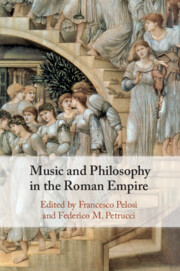Book contents
- Music and Philosophy in the Roman Empire
- Music and Philosophy in the Roman Empire
- Copyright page
- Contents
- Notes on Contributors
- Acknowledgements
- Abbreviations
- Introduction
- Chapter 1 The Scala Naturae and Music
- Chapter 2 Music and Plutarch’s Platonic Cosmos
- Chapter 3 The Harmoniser God
- Chapter 4 Alexander of Aphrodisias and Musical Models for Ontological Enquiries
- Chapter 5 How to Resist Musical Dogmatism
- Chapter 6 Shifting Epistemological Perspectives in Ptolemy’s Harmonics
- Chapter 7 Musical Imagery in Clement of Alexandria and Origen
- Chapter 8 Plotinus on Music, Rhythm, and Harmony
- Chapter 9 Porphyry’s Commentary on Ptolemy’s Harmonics
- Chapter 10 The Music of the Virtues in Late Ancient Platonism
- Chapter 11 Harmonics as Theological Paradigm in Proclus
- Chapter 12 Calcidius on Cosmic Harmony
- Chapter 13 Harmonia in Philoponus’ Commentary on Nicomachus’ Introduction to Arithmetic
- Bibliography
- Index Locorum
- General Index
Chapter 8 - Plotinus on Music, Rhythm, and Harmony
Published online by Cambridge University Press: 27 November 2020
- Music and Philosophy in the Roman Empire
- Music and Philosophy in the Roman Empire
- Copyright page
- Contents
- Notes on Contributors
- Acknowledgements
- Abbreviations
- Introduction
- Chapter 1 The Scala Naturae and Music
- Chapter 2 Music and Plutarch’s Platonic Cosmos
- Chapter 3 The Harmoniser God
- Chapter 4 Alexander of Aphrodisias and Musical Models for Ontological Enquiries
- Chapter 5 How to Resist Musical Dogmatism
- Chapter 6 Shifting Epistemological Perspectives in Ptolemy’s Harmonics
- Chapter 7 Musical Imagery in Clement of Alexandria and Origen
- Chapter 8 Plotinus on Music, Rhythm, and Harmony
- Chapter 9 Porphyry’s Commentary on Ptolemy’s Harmonics
- Chapter 10 The Music of the Virtues in Late Ancient Platonism
- Chapter 11 Harmonics as Theological Paradigm in Proclus
- Chapter 12 Calcidius on Cosmic Harmony
- Chapter 13 Harmonia in Philoponus’ Commentary on Nicomachus’ Introduction to Arithmetic
- Bibliography
- Index Locorum
- General Index
Summary
From the very early treatises, Plotinus highlights that the perception of harmonies and rhythms could lead up to the grasp of intelligible harmony. While Plotinus abandons the link between music and astronomy, distinguishing himself from the general reading of Plato developed in the imperial era, he stresses the psychagogical dimension of music. On the one hand, he simplifies the analyses devoted to music as a preparatory discipline, but on the other, he draws upon examples from the arts of rhythm (namely dance and music) to illustrate key aspects of his cosmology and of causal processes. After reviewing the place of music in Plotinus’ metaphysical organization, this chapter examines the use Plotinus makes of images related to music, dance and rhythm to exemplify different causal relationships. It concludes with an analysis of the meaning of a hapax, the adjective arrhythmistos taken from Aristotelian doxography and initially associated with the primordial indetermination of matter. These considerations lead to the conclusion that, in the Enneads, the concept of rhythmos goes beyond the field of musical arts and denotes the dynamic productivity of intelligible realities.
- Type
- Chapter
- Information
- Music and Philosophy in the Roman Empire , pp. 178 - 197Publisher: Cambridge University PressPrint publication year: 2020
- 1
- Cited by

